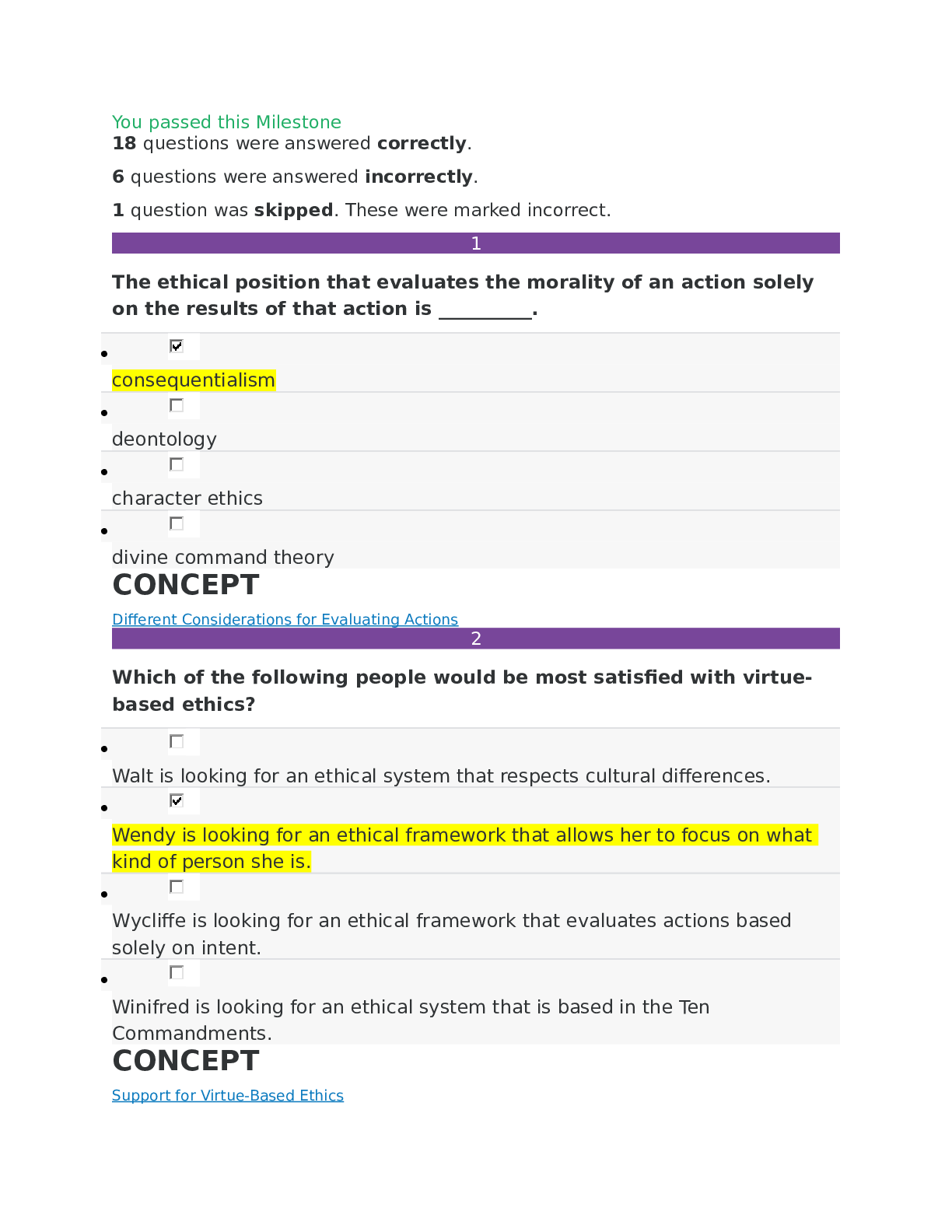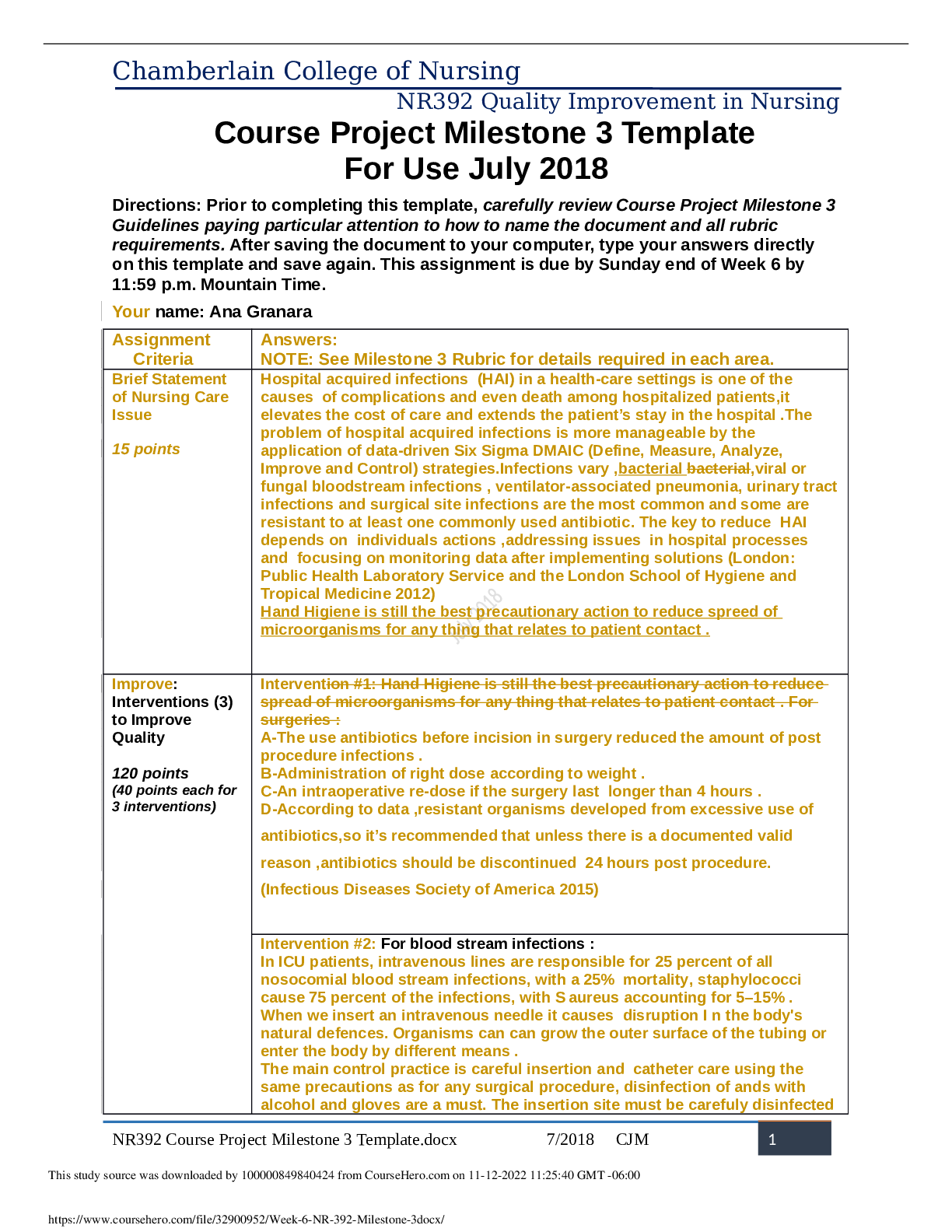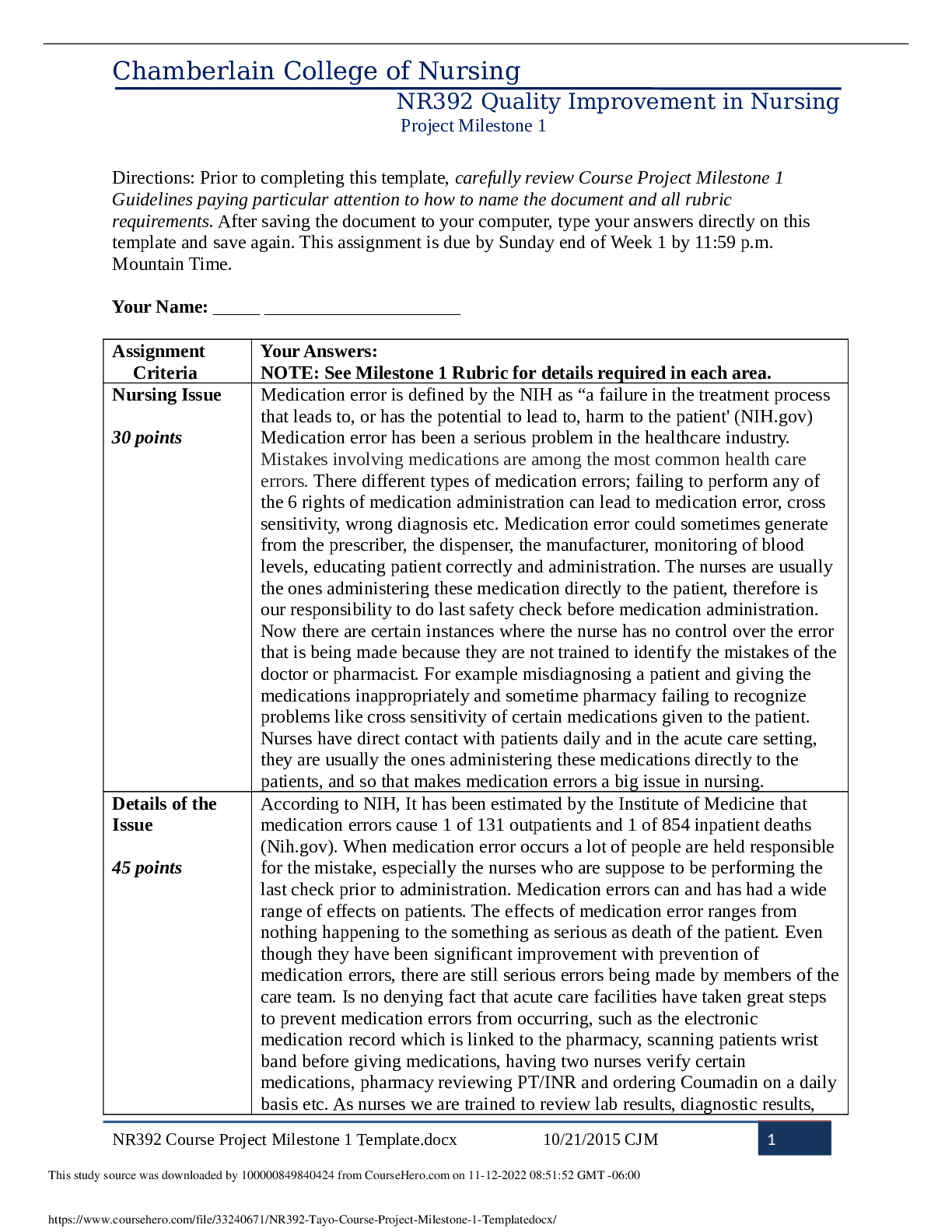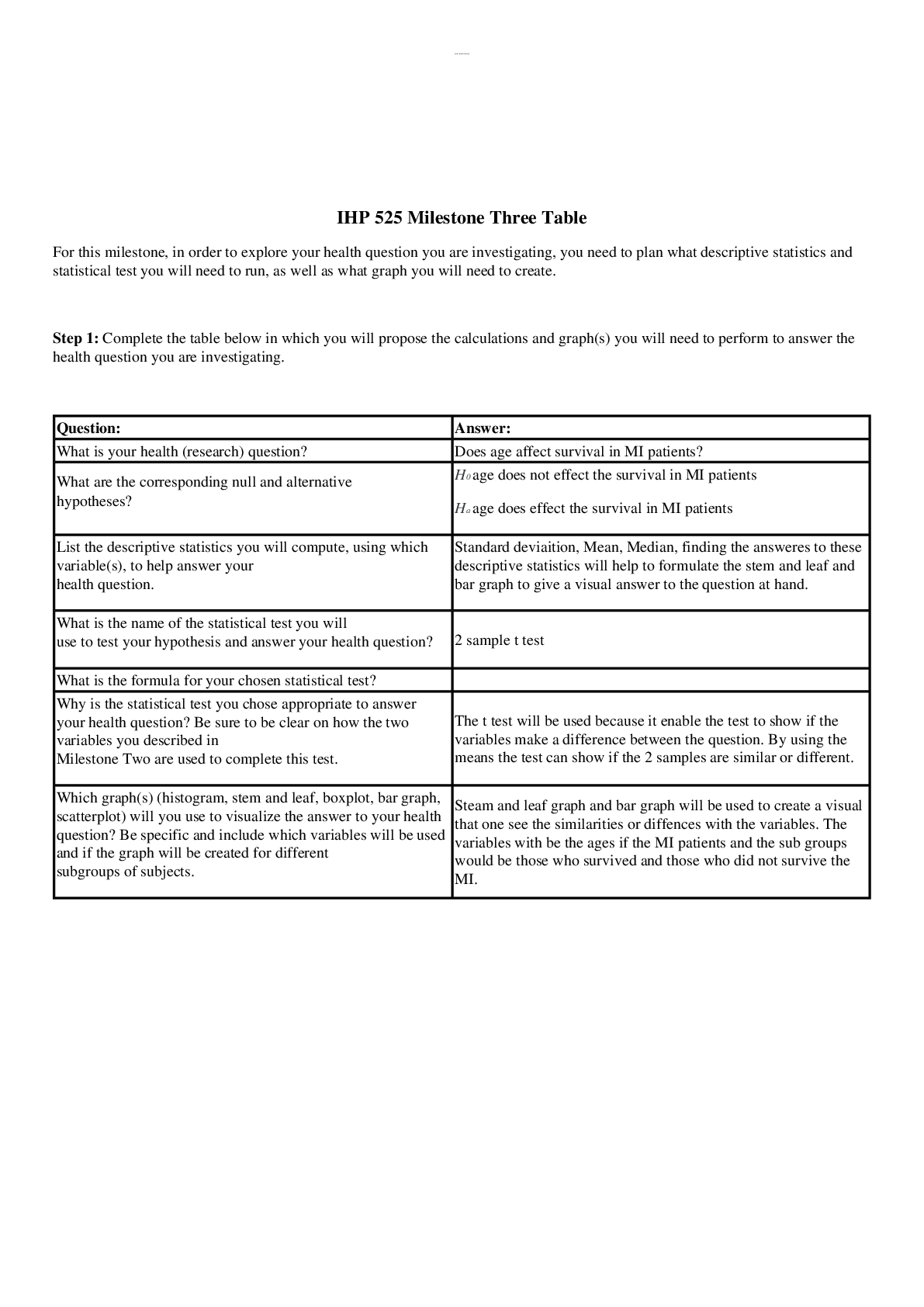MIS 589 Week 5 Project Milestone: The Role of the Internet and Wide Area Network Technologies (RATED A+)
Document Content and Description Below
MIS 589 , DeVry University
Applied Research Project
Milestone 0, Proposal Draft Milestone 1, Proposal
Milestone 2, Network Requirements 1
-Physical, Data Link , Network Layers Milestone 3, Netwo
...
rk Requirements 2
-LAN and Backbone Network Milestone 4, Network Requirements 3
-WAN and Internet
Milestone 5, Network Security and Management
- Inventory of Assets
- Threat Scenario 1
- Network Manager job posting
- Project Experience
Name
MIS589 Project Milestone 0 Proposal Draft
VPN (Virtual Private Network) E-commerce
Prepared by:
Approved by:
1. Description of the service-summary
A VPN or Virtual Private Network is a method used to add security and privacy to private and public networks, like WiFi Hotspots and the Internet. VPNs are most often used by corporations to protect sensitive data.
2. Intended clients or customers
Any business or company to allow employees to have easy access and connection, even while traveling, to resources that you may not be able to access on another network. If you are using your own VPN, you’ll be able to bypass filters and censorship set by schools and workplaces, and browse anonymously on campus or at work. Even in public places, you can rest assured that your important work is protected from prying eyes and your user data is safe.
3. Business objective statement
VPNs allow employee flexibility where network access is needed outside of the business place to perform any business functions including: email, network applications, database access or any other application hosted within the business network.
4. Application architecture description
Data storage, data access logic, application logic, presentation logic.
The VPN will allow customers to connect securely with sales reps, accouting/billing, or customer service. Clients will be able to access their file accounts, order history, profile and payment methods. Text information will be available and videos will be available for product demonstrations and other marketing related items. Employees will have full access to their accredited software and network locations from any geographic location. Employees will have access to email, instant messaging and video conferencing capabilities.
IPSec protocols will be used but will also be paired with tunneling protocols where needed and SSL protocols for more sensitive information.
5. Information provided to the clients
The VPN will allow customers to connect securely with sales reps, accouting/billing, or customer service. Clients will be able to access their file accounts, order history, profile and payment methods. Text information will be available and videos will be available for product demonstrations and other marketing related items.
6. Basic requirements
Basic requirements of a VPN include data storage, client VPN software, VNP aware routers and firewalls, and a VPN dedicated server
Conclusion
Clients and employees alike will have secure access to pertinent information through dedicated connections from anywhere in the world.
MIS589 Project Milestone 1 Proposal
VPN (Virtual Private Network) E-commerce
Prepared by: Daniel Wubbena
Date: 05/15/2016
Approved by:
1. Description of the service-summary
A VPN or Virtual Private Network is a method used to add security and privacy to private and public networks, like WiFi Hotspots and the Internet. VPNs are most often used by corporations to protect sensitive data.
2. Intended clients or customers
Any business or company to allow employees to have easy access and connection, even while traveling, to resources that you may not be able to access on another network. If you are using your own VPN, you’ll be able to bypass filters and censorship set by schools and workplaces, and browse anonymously on campus or at work. Even in public places, you can rest assured that your important work is protected from prying eyes and your user data is safe.
3. Business objective statement
VPNs allow employee flexibility where network access is needed outside of the business place to perform any business functions including: email, network applications, database access or
any other application hosted within the business network.
4. Application architecture description
5. Information provided to the clients
6. Basic requirements
Conclusion
Network Requirements 1 Physical, Data Link, Network Layers
E-commerce
Prepared by: Dan Wubbena
Date: 05/21/16
Approved by:
Summary of physical media and network design for the proposed service (max 200 words)
The VPN does not really alter the Physical Layer requirements, as a network is a network. Ideally fiber optics should be used, but CAT5 may have to suffice depending on financial budget constraints. The Data Link layer will be discussed ensuring the most efficient use of bandwidth for customers and employees to access the VPN. Since the VPN will most likely occupy the Layer 3 Network Layer, the specific components of Layer 1 and Layer 2 will be considered somewhat generic.
A. Physical media selection: summary Cat 5 or fiber optics, Wifi
A.1 Physical media consideration: Types of network and transmission distances
Distances will be of very little concern considering the purpose of a VPN is to allow network access from any geographic location that provides internet access. GRE tunneling will be used through the service provider to provice point to point access communication.
A.2 Physical media consideration: cost
Some significant cvosts may be incurred in future Layers for specific software, but the overall costs of the Physical Layer 1 will be minimal…only CAT 5 of Fiber Optics
B. Medium access
C. Network design
D. Network layer
Conclusion
MIS589 Project Milestone 3
Network Requirements 2 LAN and Backbone Network
VPN
E-commerce
Prepared by : Daniel Wubbena
Date: 05/27/2016
Approved by:
Summary of LAN or backbone network for the proposed network (max 200 words)
This section will cover the components, technologies, tunneling and VPN security measures needed for this project to be successful. This information will include, but not be limited to, remote access, site-to-site, connectivity, transit times and network topology.
A. LAN design summary
Basic requirements of a VPN include data storage, client VPN software, VNP aware routers and firewalls, and a VPN dedicated server
A.1 Wired or wireless LAN functions
The VPN will allow customers to connect securely with sales reps, accouting/billing, or customer service. Clients will be able to access their file accounts, order history, profile and payment methods. Text information will be available and videos will be available for product demonstrations and other marketing related items. Employees will have full access to their accredited software and network locations from any geographic location. Employees will have access to email, instant messaging and video conferencing capabilities
A.2 Wired or wireless LAN link and device requirements
DSL for voice, data and voice/data.
C10 Communications ADSL filter splitter CAT 5 cabling
4 ASUS RT-AC87U Routers (two for ISP, two for VPN)
6 Servers: Data, proxy, communiCISCO VPN 3002cation, application, VPN, backup
A.3 Wired or wireless LAN bandwidth and performance requirements
30 concurrent VPN connections desired, so bandwidth requirements will require at least 10Mbps
B. Backbone network (if applicable)
It may be possible that a MPLS VPN backbone network would be required, however the business would first need a complete evaluation. I would assume at this point, it would NOT be needed, but should be in the short term strategic plan to accommodate for business growth.
Conclusion
MIS589 Project Milestone 4
Network Requirements 3 WAN and Internet
(Name of your service)
(Name of your company or business)
Prepared by: (Your Name)
Date:
Approved by:
Summary of WAN and Internet requirements for the proposed network (max 200 words)
VPNs are built on top of a publicly-accessible infrastructure, such as the Internet or the public telephone network. They use some form of encryption and have strong user authentication. Essentially a VPN is a form of WAN; the difference is their ability to use public networks rather than private leased lines. A VPN supports the same intranet services as a traditional WAN, but also supports remote access service. This is good for telecommuting, as leased lines don’t usually extend to private homes and travel destinations. A remote VPN user can connect via an Internet Service Provider (ISP) in the usual way. This eliminates long- distance charges. The user can then initiate a tunnel request to the destination server. The server authenticates the user and creates the other end of the tunnel. VPN software encrypts the data, packages it in an IP packet (for compatibility with the Internet) and sends it through the tunnel, where it is decrypted at the other end. There are several tunneling protocols available: IP security (IPsec), Point-to-Point Tunneling Protocol (PPTP) and Layer 2 Tunneling Protocol (L2TP).
A.1 Need for WAN connectivity
WAN is not needed
A.2 Traffic through the WAN None necessary
A.3 Possible WAN options
none
A.4 Explain your cnonhoice for WAN service none
B.1 Role of Internet in your network Critical. Not possible without
Pro and cons of using Internet in business Only choice for e-commerce business
Conclusion
VPNs are built on top of a publicly-accessible infrastructure, such as the Internet or the public telephone network. They use some form of encryption and have strong user authentication. Essentially a VPN is a form of WAN; the difference is their ability to use public networks rather than private leased lines. A VPN supports the same intranet services as a traditional WAN, but also supports remote access service. This is good for telecommuting, as leased lines don’t usually extend to private homes and travel destinations. A remote VPN user can connect via an Internet Service Provider (ISP) in the usual way. This eliminates long- distance charges. The user can then initiate a tunnel request to the destination server. The server authenticates the user and creates the other end of the tunnel. VPN software encrypts the data, packages it in an IP packet (for compatibility with the Internet) and sends it through the tunnel, where it is decrypted at the other end. There are several tunneling protocols available: IP security (IPsec), Point-to-Point Tunneling Protocol (PPTP) and Layer 2 Tunneling Protocol (L2TP).
Inventory of Assets
Asset Importance Most Important
Security Requirement Description Owner(s)
MIS589 Project Milestone 5
Network Security
Threat Scenario
Asset
Asset Importance
Threat
Description
Likelihood
Impact on Confidentiality
Integrity
Availability
Impact Area Priority Impact Score
Financial
Productivity
Reputation
Legal
Impact Score
Risk Score (likelihood x Impact Score)
Risk Control Strategy Accept
Mitigate
Share
Defer
Risk Mitigation Controls
[Show More]
Last updated: 3 years ago
Preview 1 out of 13 pages




 NRS428V week 5 Benchmark – Community Teaching Plan Community Presentation, Latest Summer 2021.png)


.png)









.png)
.png)













